With the Flow Ohio – Watershed Report for the Week of Dec 6 to 12
By Gillian Ward
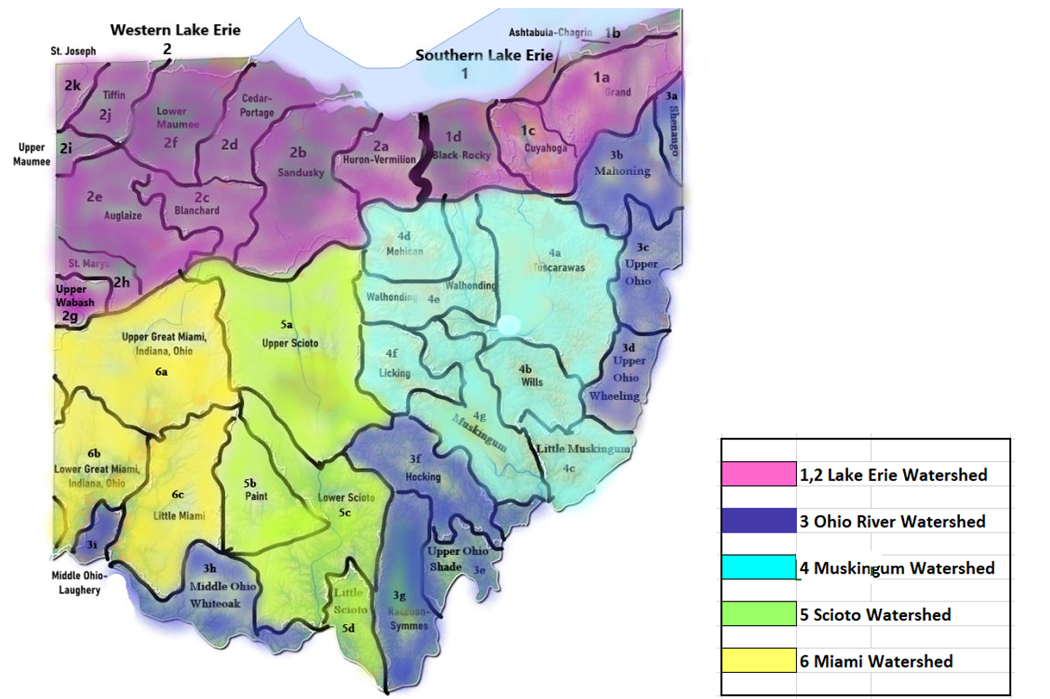
With the Flow Ohio tracks trends in your watershed, posting weekly updates from USGS WaterWatch Current Streamflow and Ohio EPA Division of Drinking and Ground Waters.
USGS WaterWatch Current Streamflow weekly report data is captured from real time monitoring stations, including the flow volume as percentage of average (mean), flow volume in cubic feet per second, flow depth and temperature, where available. A river or stream that has reached flood action stage is shown in bold text, a system in flood stage appears in red.
USGS Groundwater Watch – data captured from well sites, including depth (in feet) from ground surface to reach water level; the higher measurement represents lower groundwater level.
Public Drinking Water systems are added to our database each week - active (A) community (C) systems sourced from groundwater or surface water for residential delivery, by watershed. Recent violations and enforcement orders, lead and copper test results as posted in Ohio EPA Drinking Water Watch are included. For more information, see report key at the end of this document.
EPA Lead and Copper Rule
USA Environmental Protection Agency upholds and enforces drinking water for public water systems through the Safe Water Act. Lead can enter the drinking water stream when corrosion occurs in certain types of distribution lines and connections Lead is toxic when consumed, and accumulates in the body over time. The effects of lead toxicity may present as stomach upset to brain damage.
WTOH tracks lead and copper test results by watershed, as published by EPA Ohio on their Drinking Water Watch database.
Public Water systems sample and test for lead and copper at customer taps periodically through the year. While there is no safe level of lead in drinking water, and the maximum non-enforceable target for drinking water is set to 0, the EPA requires action steps be taken when more than 10% of customers are found to have 15 parts per billion lead at their taps, or 0.015 mg/l. Action level for copper is 1.3 mg/l.
1,2 Lake Erie Watersheds
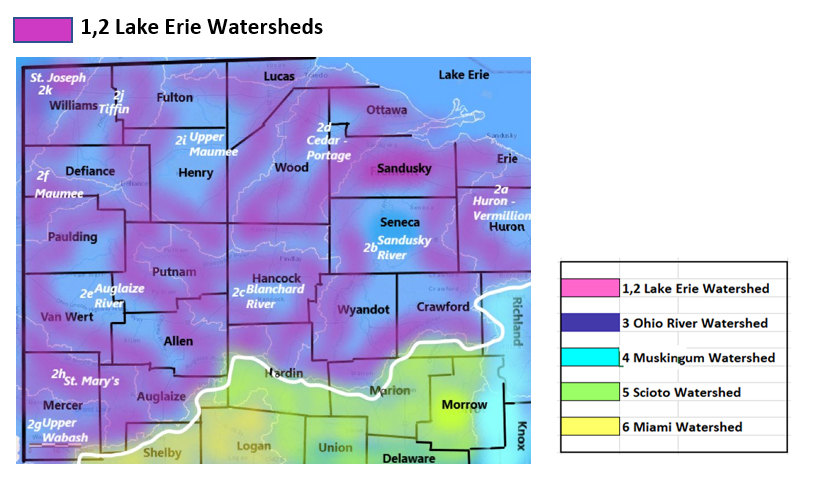
1 Southern Lake Erie
1a Grand River Watershed
Flows: capturing rainfall and snowmelt from parts of Ashtabula, Lake, Geauga, Portage, Trumbull Counties
- Conneaut Creek drains an area of 175 sq miles in Ashtabula County; at Conneaut station, the flow is rated “normal”; 44% above mean flow rate at 192 cfs. Depth of flow is 2.14 ft.
- Grand River drains 685 sq miles in Lake County; the flow near Painesville is “normal”, 91% above mean at 1230 cfs and 3.62 ft deep, 4.1°C Minor flood stage at this station is 12.5 ft.
Specific conductance 295µS/cm
(Flow information updated 2021-12-05)
Groundwater Monitor Geauga County
USGS 412331081123000 GE-22 Groundwater monitoring station in Geauga County reporting 13.14 feet depth to water level, feet below land surface (updated Dec 2, 2021)
1b Ashtabula River - Chagrin River Watershed
Flows: catching parts of Ashtabula, Lake, Cuyahoga, Geauga, Portage Counties
- Chagrin River drains an area of 246 sq miles of Lake County into Lake Erie. Flow is normal at Willoughby station, 117.48% above mean and discharging 289 cfs. The gage height (flow depth) is 3.73 ft.
- Unnamed tributary to Chagrin River drains 7.69 sq miles of Cuyahoga County. The flow at Pepper Pike is 5.22 cfs and 6.17 ft deep; flow at Mayfield Village is 69% above mean, .68 cfs and .58 ft deep.
(Flow information updated 2021-12-05)
1c Cuyahoga River Watershed
Flows: parts of Cuyahoga, Summit, Portage, Geauga Counties
- Cuyahoga River drains an area of 788 sq miles in Ohio. With its headwaters in Geauga County, Cuyahoga takes a loop south into Portage and then hooks back north through Summit, passing through Cuyahoga County to discharge into Lake Erie. At Hiram Rapids, the nearest monitoring station to the headwaters in Geauga County, the flow is normal, 121.68% above mean at 311 cfs and 2.6 ft deep; at Old Portage, 119% above mean at 562 cfs and 3.93 feet deep; at Jaite station normal, 85% above mean at 537 cfs and 3.25 ft deep; at Independence station, flowing normal, 100% above mean at 901 cfs and 4.21 ft deep, 4.6°C; at the Newburgh Heights station nearest the outlet in Cuyahoga County flow is normal, 70% above mean at 1040 cfs; water temperature is 6.4° (flow information updated 2021-12-05)
- West Creek drains an area of 9.23 sq miles in Cuyahoga County. The flow at Ridgewood Road, Parma is flowing normal, 11.53% above mean at 1.6 cfs and 4.69 ft deep; at Brooklyn Heights (nearest to the outlet) flowing normal, 39% above mean at 5 cfs and 1.2 ft deep. (flow information updated 2021-12-05)
- Mill Creek gathers runoff and drains 12.9 sq miles in the Cuyahoga River watershed; the flow is monitored at Garfield Heights 37 % above mean and 10 cfs and .84 ft deep. (flow information updated 2021-12-05)
- East Branch Big Creek collects flow from 19.2 sq miles in Cuyahoga County. The flow at Brooklyn is 61% above mean at 8.33 cfs and 2 ft deep. (flow information updated 2021-12-05)
- Brandywine Creek drains an area of 16.4 sq miles in Summit county. The flow near Macedonia is 2.75 ft deep, flood stage is 13 ft. (flow information updated 2021-12-05)
- Tinkers Creek drains an area of 83.9 sq miles of Cuyahoga County, flow at Bedford is back to normal this week, 57.57% above mean flow at 89.4 cfs and 2.74 ft deep. (flow information updated 2021-12-05)
- Chippewa Creek drains an area of 17.5 sq miles Cuyahoga County before joining the Cuyahoga River. The flow near Breckville is normal, 66% above mean at 6.72 cfs and 2.67 ft deep. (flow information updated 2021-12-05)
1d Black River - Rocky River Watershed
Flows: runs off parts of Lorain, Ashland, Huron, Cuyahoga Counties
- Rocky River drains an area of 267 sq miles into Lake Erie. Flow at Berea is rated normal, 53% above mean flow, 178 cfs and 5.59 ft deep. The water temp 4°
- Plum Creek drains 15.7 sq miles in Cuyahoga County. The flow near Olmstead is 16% above mean, 4.69 cfs and 2.08 ft deep.
- Black River drains an area of 396 sq miles of Lorain County into Lake Erie. Flow at Elyria is normal this week, 57% above mean flow, 214 cfs and 2 ft deep. The water is 4.6° Specific conductance 595 µS/cm (flow information updated 2021-12-05)
(Flow information updated 2021-12-05)
2 Western Lake Erie Watersheds
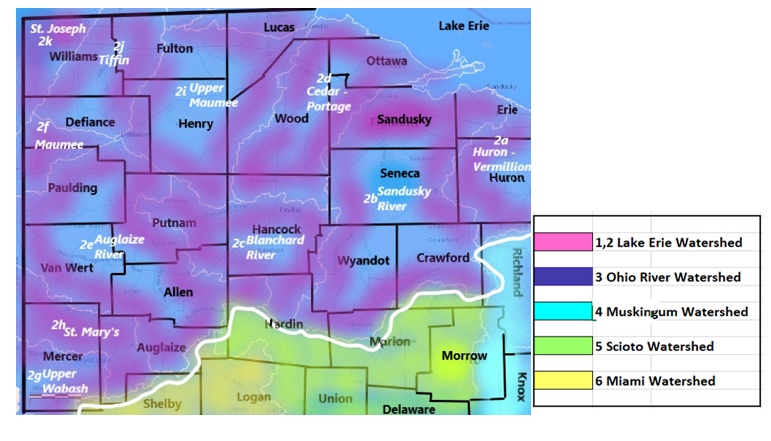
Flow information updated November 24, 2021
2a Huron River/Vermillion River
Flows: parts of Erie, Huron, Lorain Counties
- Vermillion River drains an area of 262 sq miles of Lorain County into Lake Erie just east of Sandusky Bay. Flow at the Vermillion monitoring station is 69% above mean flow at 160 cfs and 2.65 ft deep; 3.4°C; 589 µS/cm
- Huron River drains an area of 371 sq miles of Huron County into Lake Erie east of Sandusky Bay. Flow at the Milan station is 49% above mean flow at 162 cfs and 6.85 ft deep. The water is 3.3°C; 686 µS/cm
- Old Woman Creek drains 22.1 sq miles in Erie County. At Berlin Rd near Huron, the flow is normal, 18% above mean at 4.58 cfs, 2 ft deep.
(flow information updated 2021-12-05)
2b Sandusky River Watershed
Flows: parts of Sandusky, Seneca, Wyandot, Crawford (4 Main) also parts of Erie, Ottawa, Wood, Huron, Hancock, Hardin, Marion, and Richland counties
- Sandusky River drains an area of 1251 sq miles in Crawford and Wyandot Counties. The flow near Bucyrus in Crawford County is normal, 72% above mean at 51.3 cfs and 1.19 ft deep; near Upper Sandusky normal flow, 72% above mean at 139 cfs and 1.82 ft deep; at Fremont, 37% above mean flow at 383 cfs and 1.53 ft deep; 4.8 °C.
- Honey Creek drains an area of 149 sq miles of Seneca County into Sandusky River. The flow at Melmore in Seneca County is normal, 36% above mean at 57.4 cfs and 2.58 ft deep.
- Rock Creek drains an area of 34.6 sq miles in Seneca County into Sandusky River. The flow at Republic is 5% above mean at .37 cfs and 3.9 ft deep; at Tiffin the flow is 24% above mean at 10.6 cfs and 3.76 ft deep
- Tymochtee Creek drains an area of 229 sq miles in Wyandot County into Sandusky River. The flow at Crawford is 10.4% above mean at 23.7 cfs and 2.14 ft deep.
(Flow information updated 2021-12-05)
2c Blanchard River Watershed
Flows: drains parts of Hardin, Hancock, Putnam, Seneca, Allen, Wyandot Counties
- Blanchard River drains 756 sq miles of Hancock and Putnam Counties into Auglaize River and on to Lake Erie. The flow measured nearest the headwaters below Mt. Blanchard is 8.66% above mean at 12 cfs and 2.91 ft deep; the flow above Findlay is 5.57% above mean at 10.8 cfs and 5.49 ft deep; near Findlay 13% above mean, 32.3 cfs and .95 ft deep. The water is 7° C; at Gilboa 11.55% above mean at 43.5 cfs and 4.15 ft deep; at Ottawa in Putnam County is 19% above mean at 71.7 cfs and 5.44 ft deep; near Dupont is 46% above mean at 91.2 cfs and 5.72 ft deep
- Lye Creek drains an area of 18.8 sq miles. The flow above Findlay is 6% above mean at 1.75 cfs and 1.12 ft deep.
- Eagle Creek drains an area of 51 sq miles in Hancock County. Flow is 6.5% above mean at 4.53 cfs and 3.1 ft deep. The water is freezing, 0°C and 440 µ/cm.
(flow information updated 2021-12-05)
2d Cedar River-Portage River Watershed
Flows: catches parts of Hancock, Wood, Seneca, Sandusky, Ottawa Counties
- Portage River drains an area of 494 sq miles of at Sandusky County. The flow at Woodville is 44% above mean, 133 cfs and 2.6 ft deep. The water is 5.3°C; near Elmore the flow is 41% above mean at 147 cfs and 2.57 ft deep
(flow information updated 2021-12-05)
2e Auglaize River Watershed
Flows: washes parts of Defiance, Fulton, Henry, Lucas, Paulding, Williams, Wood Counties
- Auglaize River drains an area of 2318 sq miles into Maumee River, where it empties into the western part of Lake Erie. The flow station closest to headwaters is at Kossuth in Allen County. Flow here is 38% above mean at 47.8 cfs and 5 ft deep; flow at Fort Jennings is low, 5.27% above mean at 15.5 cfs and 1.9 ft deep; flow near Dupont is 12.71 ft deep; flow near Defiance is normal, 25% above mean, 438 cfs and 6.09 ft deep.
- Little Flat Rock Creek drains an area of 15.2 sq miles in Paulding County into Auglaize River. The flow near Junction is 16% above mean, .52 cfs and 2.22 ft deep.
- Little Auglaize River drains an area of 401 sq miles in Paulding County into Auglaize River. The flow at Melrose is 84% above mean at 114 cfs and 13.43 ft deep.
(flow information updated 2021-12-05)
2f - Lower Maumee River Watershed
Flows: streams from parts of Defiance, Fulton, Henry, Lucas, Paulding, Williams, Wood Counties
- The entire Maumee River drains an area of 6330 sq miles of Ohio State. The lower portion flow at Waterville is normal, 37% above mean, 1880 cfs and 2.73 ft deep, 4.7°C and 739 µ/cm.
- Ottawa River drains an area of 350 sq miles in Lucas County directly into western Lake Erie. The flow near Kalida is normal, 49% above mean at 62.2 cfs and 4.26 ft deep; University of Toledo at Toledo is normal 81% above mean, 90.7 cfs and 3.73 ft deep.
- Wolf Creek drains an area of 24.8 sq miles in Lucas County. The flow at Holland is normal, 99% above mean at 19.2 cfs and 2.13 ft deep.
(flow information updated 2021-12-05)
2g Upper Wabash River Watershed
Flows: from parts of Mercer, Darke Counties
The headwaters of the Wabash River are in Ohio, however, USGS does not monitor flows on this system in the state of Ohio. Spills and weather incidents in this area will be noted as they occur, the residue flows west out of state.
2h St. Mary’s River Watershed
Flows: from Mercer, Van Wert
- Mary’s River drains an area of 386 sq miles in Mercer and Van Wert Counties. From the headwaters in Mercer County, St. Mary’s flows west into Indiana into the Maumee River, which crosses back into Ohio and empties into Lake Erie. The flow at Rockford is 13% above mean, 66.4 cfs and 2.15 ft deep; the flow at Walcot Street at Willshire is 17.4% above mean, 92 cfs and 2.96 ft deep.
(Flow information updated 2021-12-05)
2i Upper Maumee River Watershed
Flows: parts of Paulding and Defiance Counties
- The upper Maumee River drains an area of 2129 sq miles of Paulding County. The flow at Antwerp is 61% above mean at 889 cfs and 7.53 ft deep, 23°C, 451 µ/cm; near Defiance 37% above mean at 1690 cfs and 2.18 ft deep, 4.8°C
- Platter Creek drains an area of 19.5 sq miles of Defiance County into Maumee River. The flow at Sherwood is 18.5% above mean at 1.13 cfs and 1.54 ft deep.
(Flow information updated 2021-12-05)
2j Tiffin River
Flows: wetting parts of Williams, Defiance Counties
- Tiffin River starts drains an area of sq miles in Williams and Defiance Counties. Tiffin flows south and gathers in runoff from Defiance County before joining the Maumee River. The flow monitoring station nearest the headwaters is located at Stryker in Williams County: normal, 98% above mean, 344 cfs and 6.59 ft deep; near Evansport is 92% above mean, 421 cfs and 12.74 ft deep. (flow information updated 2021-12-05)
2k St. Joseph River
Flows: Williams, Defiance, Lucas
- Joseph River drains an area of 610 sq miles in Defiance County. The flow at Newville is 179% above mean, 468 cfs and 6.2 ft deep.
(flow information updated 2021-12-05)
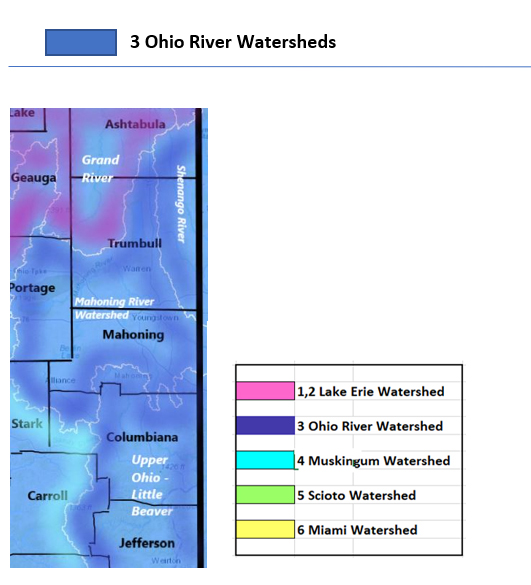
3 Ohio River Tributaries
3a Shenango River Watershed
The paddle-popular Shenango River system originates in Pennsylvania’s Shenango Valley. The river flows in and out of northeast Ohio, winding its way through west PA on its way down to meet the Ohio River. “The Shenango River Watchers is a 501(c)(3) non-profit watershed group formed to restore and protect the environmental, scenic, and recreational attributes of the Shenango River Watershed”, mission statement of the award winning group that organizes clean-up events and an annual Thanksgiving Day 5k Gobble Wobble, taking off from Hermitage, PA. The group has information resources for paddlers on their website www.shenangoriverwatchers.org.
Flows: caught from parts of Ashtabula, Trumbull, Mahoning
USGS does not have river monitors placed on the Shenango River on the Ohio side of the border, but the following systems flowing into the Shenango River are monitored:
- Pymatuning Creek drains an area of 96.7 sq miles in Trumbull County to joing the Shenango River across the state line in Pennsylvania. The flow at Kinsman in Trumbull County is 8.34 ft deep, 3.6°C;
- Eagle Creek drains an area of 97.6 sq miles in Trumbull County, exiting the state before joining Shenango River. The flow at Phalanx Station in Trumbull County is normal, 55% above normal at 57 cfs and 5.34 ft deep
- On the Pennsylvania side of the border, the Shenango River at Pymatuning Dam is flowing above normal, 180% above mean, 502 cfs and 5.60 ft deep; at Sharpsville is normal, 96% above mean, 1010 cfs and 3.60 ft deep. The water is 4.0° Flow information updated on 2021-12-03.
3b Mahoning River
Flows: draining parts of Stark, Mahoning, Trumbull
- Mahoning River drains an area of 978 sq miles in portions of Stark and Trumbull Counties as it flows west to east, exiting the state via Trumbull County and joining Shenango River before reaching the Ohio River. The flow at Alliance, nearest the headwaters in Stark County is not rated, 3.81 ft deep and 4.7°C; below Berlin Dam near Berlin Centre is 68.6% above mean at 192 cfs and 2.48 ft deep, 5.4°C; at Princetown in Mahoning County is 89% above mean at 230 cfs and 2.61 ft deep, 5.2°C; The flow at Leavittsburg is normal, 127% above mean, 1020 cfs and 4.89 ft deep, 5.2°C; below West Ave at Youngstown is normal, 125% above mean, 1520 cfs and 3ft deep. The water is 5.4° Flow information updated on 2021-12-03.
- Mosquito Creek drains an area of 97.5 sq miles in Trumbull County before joining the Mahoning River south of Warren City. The flow measured closest the headwaters is near Greene Centre, 54.5% above mean at 15.6 cfs, 5.32 ft deep and 4.5°C; the flow below Mosquito Creek Dam near Cortland is 146% over mean at 179 cfs and 2.18 ft deep and 4.4°C
3c Little Beaver Watershed
Flows: catching parts of Jefferson, Carroll, Columbiana, Harrison
- Little Beaver River drains an area of 496 sq miles of Columbiana County into the Ohio River. The flow at East Liverpool is normal, 117% above mean flow, 331cfs and 3.5 ft deep.
- Yellow Creek drains an area of 147 sq miles in Jefferson County. Flow is “normal” at Hammondsville, 67% above mean flow at 50 cfs and 1.57 ft deep. Flow information updated on 2021-12-03.
- Short Creek drains an area of 123 sq miles in Jefferson County. Flow is “normal” at Dillonvale station, 76% above mean flow at 51.7 cfs, 2.20ft deep. Flow information updated on 2021-12-03
3d Wheeling Creek Watershed
Flows: catching parts of Belmont, Monroe Counties
- Wheeling Creek drains an area of 97sq miles in Belmont County. Flow is “normal” below Blaine, 37% above mean flow at 40 cfs and 1.24 ft deep. Flow information updated on 2021-12-03
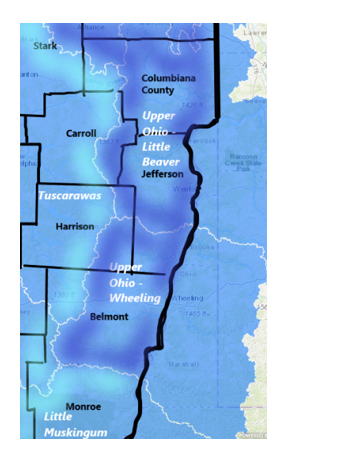
3e Shade River Watershed
Flows: parts of Meigs County
- Shade River at drains an area of 156 sq miles in Meigs County. The monitoring station located at Chester shows normal flow, 19% above mean, 32cfs and 5ft deep. The water temperature at this location is registering 4.8°C. Flow information updated on 2021-12-03
3f Hocking River Watershed
Flows: contains parts of Athens, Hocking, Fairfield Counties
- Hocking River drains an area of 943 sq miles in Hocking County; the station at Enterprise in Hocking reports normal flow, 37% above mean at 154 cfs and 0.86 ft deep; the flow is normal at Athens, registering 35% above mean flow, 296cfs and 3.40ft deep. Flow information updated on 2021-12-03.
- Clear Creek drains an area of 89 sq miles in Hocking County, joining Hocking River; the station near Rockbridge in Hocking County reports below normal flow, 26% above mean, 24 cfs, a little more than a foot deep. Flow information updated on 2021-12-03.
3g Raccoon Creek – Symmes Creek Watershed
Flows: rolling over parts of Hocking, Athens, Meigs, Vinton, Jackson, Gallia Counties
- Raccoon Creek drains an area of 585 sq miles in Gallia County. The monitoring station at Adamsville shows the river flowing normal, 36% above mean flow at 176 cfs and 3ft deep. Flow information updated on 2021-12-03.
- Symmes Creek drains 302 sq miles of Lawrence County into the Ohio River; at Aid, the flow is normal, 17% above mean at 58cfs and 6.21 ft deep. Flow information updated on 2021-12-03.
3h Middle Ohio – White Oak Watershed
Flows: we are talking about rainfall and snowmelt off parts of Brown County
- White Oak Creek drains an area of 208 sq miles in Brown County; the flow above Georgetown is 19% above mean, 33cfs and 4 ft deep. Flow information updated on 2021-12-03.
3i Middle Ohio – Laughery Watershed
Flows: rainfall and snowmelt from central Butler and Hamilton Counties
Middle Ohio- Laughery drainage area occupies just over 900 000 acres in Ohio, Kentucky and Indiana. The flow monitoring stations in Ohio are found on Mill Creek.
- Mill Creek drains an area of 115 square miles in Butler and Hamilton Counties. The flow at Evendale is 76% above mean at 34.4 cfs and 4.79 ft deep; at Sharonville the flow is 3.46 ft deep; at Carthage flow is 23% over mean at 28.8 cfs and 5.67 ft deep. Updated 2021-12-03.
- 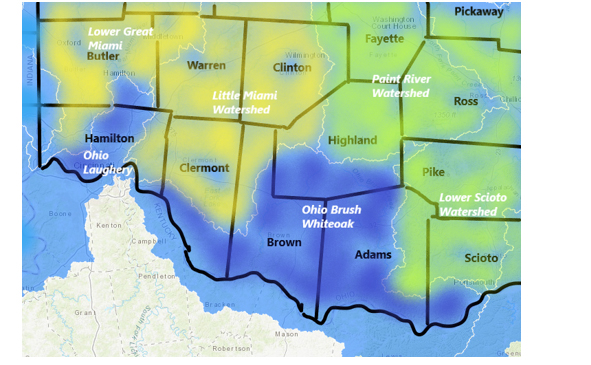
4 Muskingum River Watersheds
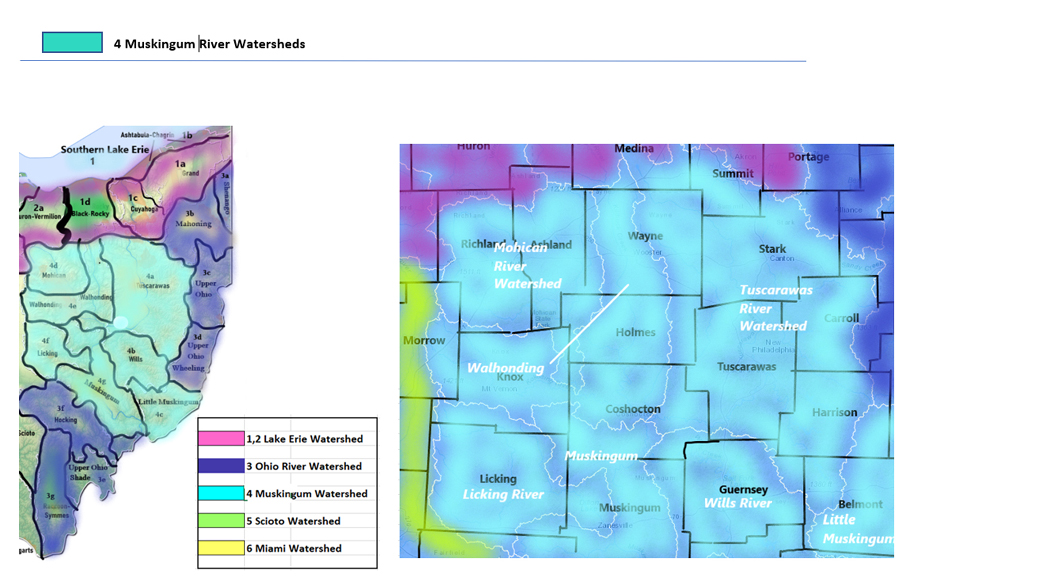
4a Tuscarawas River Watershed
Flows: parts of Tuscarawas County
- Tuscarawas River drains an area of 2443 sq miles of Tuscarawas County. The flow at Newcomerstown is normal, 64% above mean at 1770cfs and 2 ft deep. Flow information updated on 2021-12-03
4b Wills Creek Watershed
Flows: parts of Licking, Guernsey, Tuscarawas Counties
- Wills Creek drains an area of 406 sq miles in Guernsey County. The flow at Cambridge is normal, 78% above mean at 416 cfs and 4 ft deep; at Derwent flow is 6.47 ft deep. Flow information updated on 2021-12-03
4c Little Muskingum River Watershed
Flows: parts of Washington, Noble, Monroe, Guernsey
- Little Muskingum River drains an area of 210 sq miles of Washington County; at Bloomfield is flowing in the below normal range at 11% above mean, 26 cfs and 3.7ft deep. Flow information updated on 2021-12-03.
4d Mohican River Watershed
Flows: catching parts of Richland County
- Clear Fork Mohican River drains an area of 115 sq miles in Richland County. The streamflow gauge at Bellville reports flow of 2 ft deep; no volume data available. Flow information updated on 2021-12-03
- Black Fork Mohican River drains an area of 28 sq miles in Richland County. The flow at Shelby is 138% above mean at 19cfs and 6.30ft deep; unranked. Flow information updated on 2021-12-03.
4e Walhonding River Watershed
Flows: parts of Knox, Morrow, Ashland, Richland, Coshocton, Holmes Counties
- Walhonding River drains an area of 1505 sq miles in Coshocton County. The flow below Randle is 1.46 ft deep; the flow below Mohawk Dam at Nellie is 6.50 ft deep. Flow information updated on 2021-12-03
- Kokosing River drains an area of 202 sq miles in Knox County. At Mount Vernon station in Knox County, the Kokosing is flowing normal, 48% above mean flow at 103 cfs and 2.81 ft deep. Flow information updated on 2021-12-03
- Killbuck Creek drains an area of 464 sq miles in Holmes County. The flow at Killbuck in Holmes County is normal, 49% above mean flow at 175 cfs and 7.71 ft deep. Flow information updated on 2021-12-03.
4f Licking River Watershed
Flows: parts of Licking County
- Licking River drains an area of 537 sq miles of Licking County. The flow monitor at Newark is normal, 45% above mean flow at 345 cfs and 3.75 ft deep. Flow information updated on 2021-12-03
- North Fork Licking River drains an area of 241 sq miles of Licking County; at Utica in Licking County is flowing normal, 34% above mean at 30.6cfs, 7.62 ft deep; at Ohio Street in Newark the flow is 3.63 feet deep. The flow is not otherwise rated at this time. Flow information updated on 2021-12-03
- South Fork Licking River drains an area of 133 sq miles of Licking County. The station near Hebron reports normal flows, 72% above mean flow at 200 cfs and 3.48 ft deep. Flow information updated on 2021-12-03
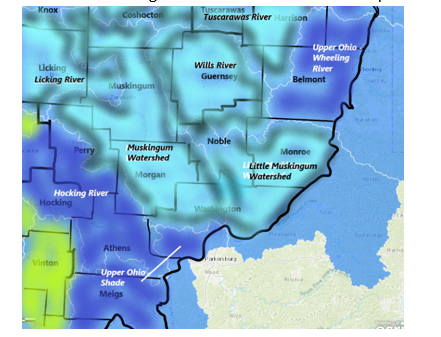
4g Muskingum River Watershed
Flows: Morgan, Washington, Noble, Muskingum, Coshocton Counties
- Muskingum River drains an area of 7947 sq miles. At Coshocton in Coshocton County the Upper Muskingum is flowing normal, 59% at 2840cfs and 7 ft deep; At Dresden in Muskingum County is flowing normal, 61% above mean at 3240 cfs and 7.75ft deep; At McConnelsville in Morgan County, the river is flowing normal, 54% above mean at 4040 cfs and 3.12ft deep. Flow information updated on 2021-12-03.
- Muskingum River (lower) at Beverly station in Washington County is 53% above mean at 4350 cfs and 16 ft deep. Flow information updated on 2021-12-03.
5 Scioto River Watersheds
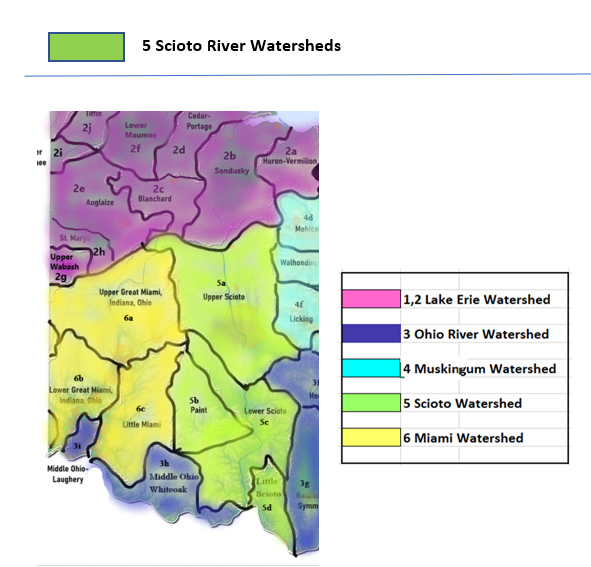
5a Upper Scioto Watershed
Flows: parts of Madison, Union, Franklin, Pickaway, Champaign, Logan, Marion, Delaware, Morrow, Crawford, Licking, Knox, Fairfield Counties
- The Upper Scioto River drains an area of 980 sq miles in Marion and Delaware Counties. The flow at La Rue in Marion County is normal, 14% above mean at 36cfs, 1.75ft deep; the flow at Prospect in Delaware County is normal, 18% above mean at 107 cfs and 1.82ft deep, water temp is 6.6C; the flow below O’Shaughnessy Dam near Dublin is normal, 23% above mean at 191 cfs, 4 ft deep; at Columbus in Franklin County is normal, 24% above mean flow at 384 cfs and 6 ft deep; near Commercial Point in Pickaway County the flow is 21% above mean at 775 cfs and 10 ft deep. Flow information updated on 2021-12-03.
- Darby Creek drains an area of 534 sq miles in Pickaway County. The streamflow gauge at Darbyville shows normal, flowing at 39% above mean at 176cfs and 3ft deep. Flow information updated on 2021-12-03.
- Alum Creek drains an area of 122 sq miles in Delaware County. The flow at Africa is normal, 10% above mean at 17 cfs and 1.45 feet deep; 7.7C. Flow information updated on 2021-12-03.
- Upper Olentangy River drains an area of 157 sq miles in Marion County, 393 sq miles by the time it reaches Delaware. The flow at Claridon in Marion County is 2.53 ft deep; the flow at Delaware in Delaware County is normal, 30% above mean at 150 cfs and 2.23ft deep; near Worthington is normal, 29% above the mean, 176 cfs and 2.18 ft deep. Flow information updated on 2021-12-03
- -
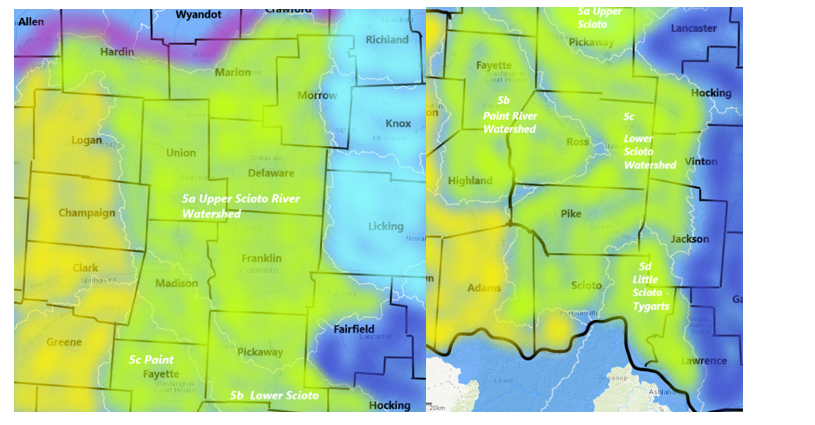
5b Paint Creek Watershed
Flows: parts of Clinton County
- Paint Creek drains an area of 249 sq miles in Clinton County. The flow near Greenfield is normal, 33% above the mean, 81cfs and 1.89 ft deep. Flow information updated on 2021-12-03
5c Lower Scioto Watershed
Flows: Parts of Madison, Highland, Franklin counties
- Scioto River (lower) drains an area of 5836 sq miles from its headwaters in Marion County down to its outlet at the Ohio River. The lower end flow at Higby in Ross County is normal, 92% above mean flow at 3030 cfs and 3 ft deep; the flow at Piketon in Pike County is normal, 63 % above mean, 3230 cfs, and 3.37 ft deep. Flow information updated on 2021-12-03.
- Deer Creek drains an area of 228 sq miles in Madison County. The flow at Mount Sterling is normal, 54% above mean at 112 cfs and 4.18ft deep. Flow information updated on 2021-12-03.
- Rocky Fork Creek drains an area of 140 sq miles in Highland County. The flow is normal, 39% above mean, 65cfs and 2.28ft deep. Flow information updated on 2021-12-03.
- Big Walnut Creek drains an area of 544 sq miles. The flow at Rees in Franklin County is normal, 26% at 145cfs and 2ft deep. Central College is normal 68% above the mean, 99 cfs, and 3.34ft deep. Flow information updated on 2021-11-24.
- Walnut Creek drains an area of 274 sq miles. The flow at Ashville is 26% above the mean, 84 cfs and 5 ft deep. Flow information updated on 2021-12-03.
5d Little Scioto Watershed
- Tygart’s Creek drains 242 sq miles in Greenup County. The flow near Greenup is normal, 59% above the mean, 117cfs and 3.22 ft deep. Flow information updated on 2021-11-24.
6 Miami River Watersheds - flow
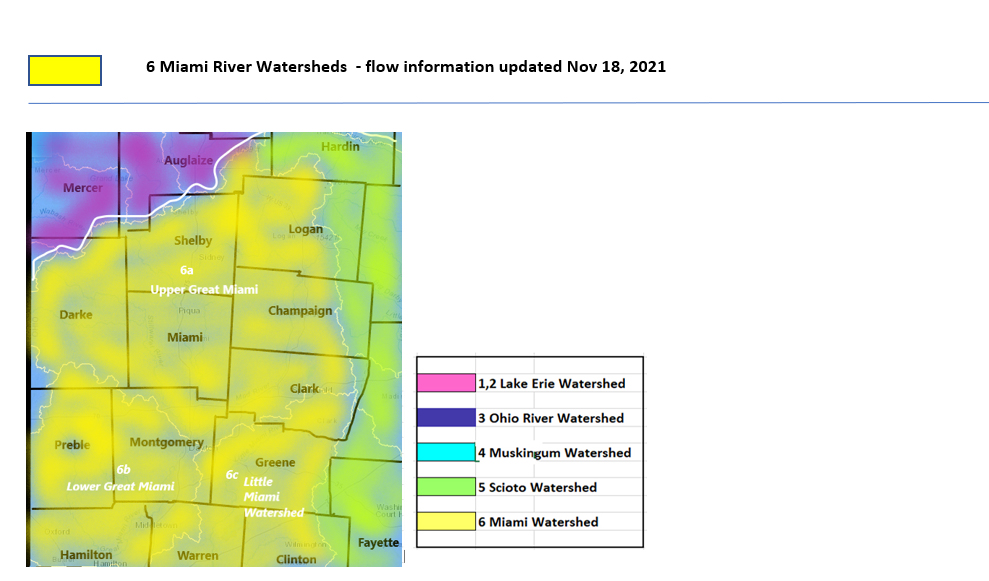
6a Upper Great Miami Watershed
- The Great Miami River (Upper) drains an area of 1149 sq miles in Hardin, Logan, Shelby, Miami and Darke and Montgomery Counties. The flow monitoring station closest to the head of the river is at Sidney, in Shelby County. The flow at Sidney is normal, 66% above mean at 229 cfs and 1.58 ft deep; at Piqua flow is 53.5% over mean at 243 cfs and 1.37 ft deep; at Troy is normal, 21% above the mean at 230 cfs and 2.28 ft deep; The flow at Taylorsville is normal, 33% above mean at 364 cfs and 2.13 ft deep (flow information updated 2021-12-03)
- Loramie Creek drains an area of 257 sq miles in Shelby County. The flow near Newport is normal, 13% above mean, 31 cfs and .71 ft deep; at Lockington in Shelby County is normal, 13% above the mean, 31 cfs and .71 ft deep. (flow information updated 2021-12-03)
- Bokengehalas Creek drains an area of 40.4 sq miles of Logan County. The station at de Graff is reporting normal, 41% above mean flow at 17.6 cfs and 1.31 ft deep; (flow information updated 2021-12-03)
- Mad River drains a combined area of 635 sq miles in Clark, Champaign, Greene and Logan Counties. The upper portion of the river is monitored from a station at West Liberty, flow is normal, 65% above mean, 22.7 cfs and 2.37 feet deep; St. Paris Pike is normal, 54% above the mean, 173 cfs and 6.15 ft deep. (flow information updated 2021-12-03)
- (Upper) Mad River drains an area of 635 sq miles in Logan and Champaign Counties. The flow near Dayton is normal, 57% above the mean, 322 cfs and 2.60 ft deep; the flow near Urbana is above normal, 127% above mean at 145 cfs and 3.1 ft deep; at St. Paris Pike near Eagle City in Clark County is flowing normal, 99% above mean at 263 cfs and 6.4 ft deep. (flow information updated 2021-12-03)
- Stillwater Creek drains an area of 503 sq miles in Miami County. The flow at Pleasant Hill is normal, 41% above the mean, 186 cfs and 1.79 ft deep. The water is 7.2°C.
- Greenville Creek drains an area of 193 sq miles in Warren and Darke Counties. The flow near Bradford is above normal, 55% above the mean, 101 cfs and 1.8 ft deep. (flow information updated 2021-12-03)
6b Lower Great Miami Watersheds
- Great Miami River drains an area of 3838 sq miles in Ohio, with the lower portion taking runoff from sq miles in Hamilton and Butler Counties. At Dayton flow is normal, 36% above mean at 1030 cfs and 24.5 ft deep; at Miamisburg, Montgomery County flow is normal, 52% above mean at 1270 cfs and 4.27; at Franklin the flow is 60% above mean at 1240 cfs and 1.19 ft deep; at Middletown flow is 41% above mean at 1450 cfs and 2.44 ft deep; at Hamilton flow is normal, 42% above mean at 1410 cfs and 63.1 feet deep; at Miamitown the flow is 1.7 ft deep (Flow information updated 2021-12-03)
- Lower Mad River drains an area of 310 sq miles in Clark, Southeast and Champaign counties. The flow at Springfield is normal, 60% above mean at 321 and 1.07 ft deep; at Dayton is normal, 45% above mean at 313 cfs and 2.58 ft; (flow information updated 2021-12-03)
- Beaver Creek drains an area of 113 sq miles in Greene County. The flow near Celina is 330% above the mean, 58 cfs, and 5.3 ft deep.
- Wolf Creek drains an area of 68.7 sq miles in Montgomery County into the Great Miami River. The flow at Dayton is normal, 32% above mean flow at 19.6 cfs and 1.33 ft deep (flow information updated 2021-12-03)
- Holes Creek drains an area of 18.7 sq miles in Montgomery County into the Great Miami River. The flow near Kettering is normal, 48% above mean at 5.18 cfs and 2.41 ft deep. (flow information updated 2021-12-03)
- Twin Creek drains an area of 275 sq miles of Montgomery County into the Great Miami River. The flow near Germantown is normal, 27% above mean at 73.7 cfs and 1.35 ft deep. (flow information updated 2021-12-03)
- Sevenmile Creek drains 69 sq miles of Preble County into the Great Miami River. The flow at Camden is normal, 38% above mean at 29.8 cfs and 3.24 ft deep. (flow information updated 2021-12-03)
6c Little Miami Watershed
- Little Miami River drains an area of 1203 sq miles in Clark and Greene Counties. The flow near Oldtown is normal, 67% above mean at 68.8 cfs and 1.7 ft deep; near Spring Valley is 2.58 ft deep; at Milford is normal, 52% above the mean, 402 cfs, and 5.28 ft deep, (flow information updated 2021-12-03)
- East Fork Little Miami River drains an area of 476 sq miles in Clermont County. Flow at Williamsburg is normal, 25% above mean at 58.9 cfs and 1.21 ft deep; below Harsha Dam near Bantam in Clermont County is 16 ft deep, water temperature is 10.5°C, the flow at Perintown is 20% above mean at 161 cfs and 2.4 ft deep (flow information updated on 2021-12-04)
- Massies Creek drains an area of 63.2 sq miles in Greene County into the Little Miami River. The flow at Wilberforce is normal at 48% above mean at 29.8 cfs and 2.44 ft deep (flow information updated 2021-12-04)
- Caesar Creek drains an area of 239 sq miles in Warren County into the Little Miami River. The flow near Wellman is 5.6 ft deep. (flow information updated 2021-12-04)
- O’Bannon Creek drains an area of 54 sq miles in Clermont County. The flow at Loveland is normal, 44% above mean flow, 10.5 cfs and 1.14 ft deep; this system has been up to 8 ft deep at peak in 2021. (flow information updated 2021-12-04)
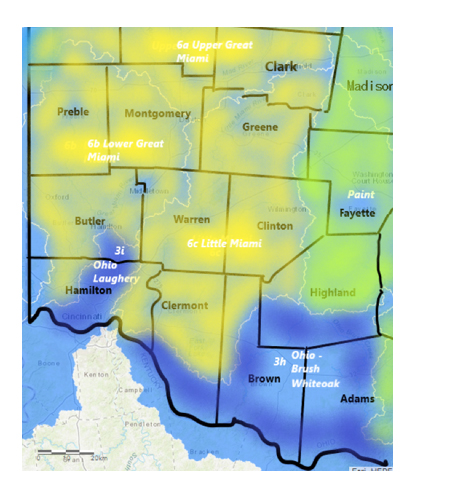
Report Key
Ohio EPA Drinking Water Watch
Public Drinking Water Source SW – Surface Water is drawn from lake, reservoir, creek or river; GW – Ground water is drawn from a well
Violations and Enforcement Actions are shown for the current year
Lead and Copper Test results are shown for the current year if available
Water systems are classified according to rules developed by the U.S. Environmental Protection Agency (EPA) and each state. Water Systems fall into two broad categories: public and non-public.
Public water systems are classified as one of the following:
|
C – Community
|
Serves at least 15 service connections used by year-round residents or regularly serves 25 year-round residents.
|
|
NTNC – Non-Transient Non-Community
|
Serves at least the same 25 non-residential individuals during 6 months of the year.
|
|
NC – Transient Non-Community
|
Regularly serves at least 25 non-residential individuals (transient) during 60 or more days per year.
|
This classification is based on information in each of the following five areas:
|
1.
|
Quantity and type of population served (e.g., transient, residential).
|
|
2.
|
Number of days served (or annual operating period (i.e., the period(s) of the year that the water system is in operation)).
|
|
3.
|
Number of service connections (i.e., the number of connections for each service area such as commercial, agricultural, residential).
|
|
4.
|
Activity status of the water system (i.e., active, or inactive).
|
|
5.
|
Sources of water (e.g., reservoir, well. Sources of water may be active or inactive depending on whether the source is seasonal or year-round. The current date determines active or inactive status).
|
|
|
|
|
|
|














